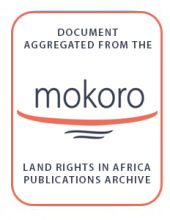Land Library
Welcome to the Land Portal Library. Explore our vast collection of open-access resources (over 74,000) including reports, journal articles, research papers, peer-reviewed publications, legal documents, videos and much more.
/ library resources
Showing items 1 through 9 of 97.For the past few decades;efforts to strengthen women’s land rights in many sub-Saharan African countries have primarily focused on a single approach: systematic registration through individual/joint certification or titling.
Companies in the business of selling farmland to billionaires and pension funds are peddling it as a green;sustainable and socially responsible investment. This propaganda is working.
There is greater recognition that policies and projects should respect legitimate tenure rights. But this concept has often proved difficult to operationalise.
For many decades communities in West and Central Africa have been facing industrial oil palm plantations encroaching onto their community land.
In Uganda land remains the most sought–after natural resource;but legal and structural mechanisms have not been effective in addressing illegal land evictions faced by vulnerable communities.
The Key Messages on Sustaining Peace through Women’s Empowerment and Increased Access to Land and Property Rights in Fragile and Conflict-affected Contexts were intended to provide a reference on how to empower women and protect their housing;land and property rights in fragile and crisis affecte
Africa’s Catholic bishops have criticized the appropriation of land;natural resources and other economic assets by private companies and called on national governments to show greater concern for local community rights and needs.
It is likely that rural women will disproportionately bear the socio-economic hardships from COVID-19. Restrictions on the movement of people and goods are disrupting agricultural value chains and food systems.
A nine-minute video. Most rural people in Uganda have rights to their rural land through customary tenure arrangements;representing 75-80% of land holdings: but only 15-20% of the land is formally registered.

